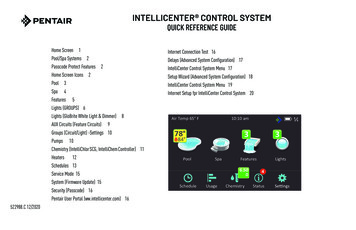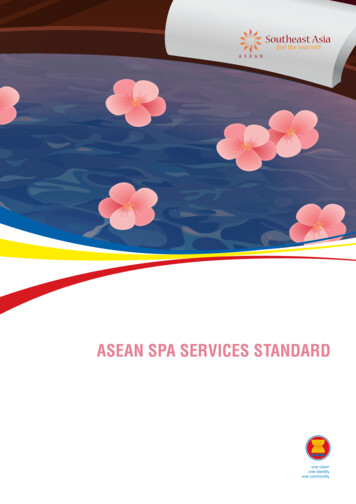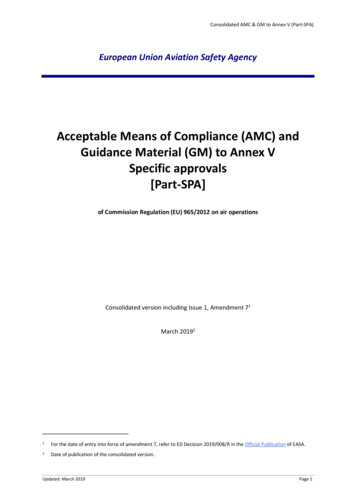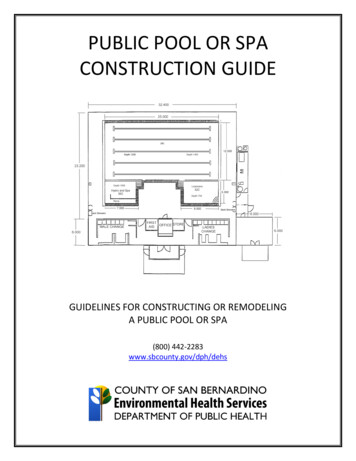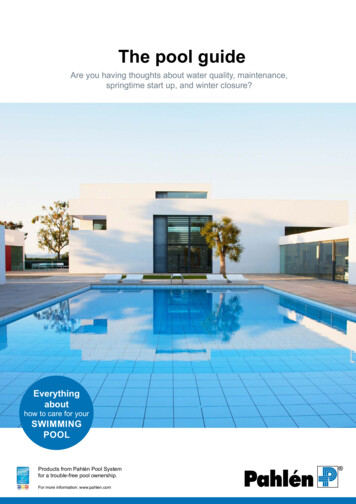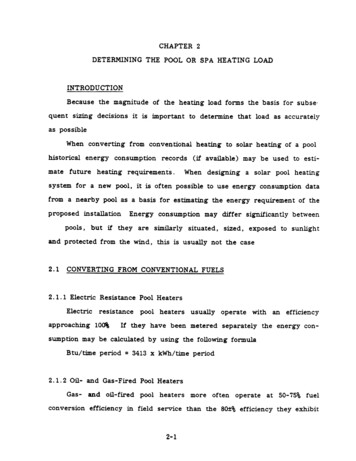
Transcription
CHAPTER 2DETERMINING THE POOL OR SPA HEATING LOADINTRODUCTIONBecause the magnitude of the heating load forms the basis for subsequent sizing decisions it is important to determine that load as accuratelyas possibleWhen converting from conventional heating to solar heating of a poolhistorical energy consumption records (if available) may be used to estimate future heating requirements.When designing a solar pool heatingsystem for a new pool, it is often possible to use energy consumption datafrom a nearby pool as a basis for estimating the energy requirement of theproposed installationEnergy consumption may differ significantly be tweenpools, but if they are similarly situated, sized, exposed to sunlightand protected from the wind, this is usually not the case2.1CONVERTING FROM CONVENTIONAL FUELS2.1.1 Electric Resistance Pool HeatersElectric resistance pool heaters usually operate with an efficiencyapproaching 100%If they have been metered separately the energy con-sumption may be calculated by using the following formulaBtu/time period 3413 x kWh/time period2.1.2 Oil- and Gas-Fired Pool HeatersGas- and oil-fired pool heaters more often operate at 50-75% fuelconversion efficiency in field service than the 8&% efficiency they e-xhibit
in laboratory testsFSEC recommends the use of a 7% conversion factorunless a substantial body of field data supports higher claimsThe aver-energy content of commonly used liquid and gaseous fuels is given inTable 2Table 2 . 1Energy Content of Oil and GasFuel(Propane)Natural gasLight home heating oilfollowing formula may be used to calculate the energy furnished bygas- and oil-fired heatersBtu/time period 0 . 7 x Btu contenthnit x units/time period2.1.3 Steam-Fired Heat ExchangersIf steam from a central boiler and a heat exchanger have been usedto heat a pool or spa, sufficient data may exist to calculate the pool heatload from the manufacturer's data on the heat exchanger effectivenessand steam quality and consumption dataIf such is not the case, weatherdata may be used to estimate the heat losses from the pool during theheating season2.1.4 Heat Pump Water HeatersDedicated heat pumps (also called heat pump water heaters) are manufactured specifically for swimming pool and spa heatingperformance (COPCoefficients ofof 4 to 8 are claimed by several of their manufactures
If the energy input of such units is separately monitored, the followingformula may be used to calculate their thermal outputBtu/time period kWh/time period x 3413 x COP2.2 CALCULATING HEAT ,LOSSES FRGM SWIMMING POOLS AND SPAS:In the absence of reliable, historical, energy-consumption data, itmay be convenient to calculate the heat losses which may be expected tooccur from a pool under various monthly weather conditionsThese lossesthen may be equated to the pool's average energy requirement for a givenincrement of timePast records of monthly average air temperatures,humidities, and pool temperatures may yield sufficiently accurate resultsfor some purposesFor other purposes, it may be necessary to makecalculations based on daily weather data and sum them to arrive at monthlytotalsWeather data for eight Florida cities is contained in Appendix EBecause the calculation procedure required is somewhat tedious, tablescontaining loss factors for six Florida cities and several pool configurationshave been developed and are presented in Appendix "G".Appropriatemonthly values may be multiplied by pool areas and to arrive at totalmonthly losses2.2.1 Heat Losses from Pools and SpasHeat Losses from .a swimming'pool or spa may be attributed to four mechanismsb1) Conduction through the pool walls.2)Convection from the pool surface*Adaptedfrom "Solar Heating for Swimming Pools", published by theEnvironmental Information Center, Winter Park, FL.
RadiationEvaporation and convection3ConductionFigure 2.1Pool Heat Loss Mechanisms3) Reradiation from the pool surface4)Evaporation from the pool surfaceFigure 2 . 1 shows the lossmechanisms and relative magnitudes for swimming pools2.2.1.1 Conduction Losses--Because most soils are poor conductors ofheat, losses through the bottoms and sides of below-grade pools are usua.aly small enough to ignore.However, if pools are situated where coldgroundwater flows past them, the following formula and heat transfercoefficients may be used to estimate the lossesThe same formula mag beused to estimate wall losses from above-ground poolsQc UxAxAt
whereQc is the conductive loss in Btu/hr,Uis the overall conductive heat transfer coefficient in t u / f t ? / h r(per OF), andAis the pool wall area in square feet (plus the area of the poolbottom in the case of below-grade pools)For below-grade pools :A t is the pool temperature minus ground water temperatureFor above-ground pools:At is the pool temperature minus air temperatureBelow Grade Pools: Even under conditions of rapid groundwaterflow, the soil close to the pool shell will rise in temperature as it absorbsheat from the poolThis reduces the temperature difference (At)Be-cause it is difficult to evaluate this reduction from individual situations,the following U values for both concrete and fiberglass walls have beenmodified using experimental data developed by ASHRAE engineers foruninsulated cement basement floorsThe U values are for use with actualpool and groundwater temperature differencesU 0.1 for 4-inconcrete pool walls with a 1-in. marble-cementwaterproof inner lining, andU 0.1 for %-in(nominal) fiberglass-reinforced plastic pool wallsThe two values are, for our purposes, the same.This is because themain resistance to heat flow is not in the wall, but is in the soil surrounding it
EXAMPLEA 30' x'45' concrete pool with an average depth of 5 feet islocated a t a canal-front motel in a Florida coastal cityThe motel managerwants to maintain the pool to 80 F during November when the groundwateris 70 FCalculate the conductive losses.Q 0 . 1 x [(301 x 5' x 2) (45' x 5' x 2) (30' x 45')lx (80 - 70 ) 2100 Btu/hr(b) Above-ground Pools:If the bottoms of such pools rest f w l y onthe ground, heat loss through them may be ignored.However, lossesthrough the walls of above-ground pools may be large enough to requireconsideration.The following overall coefficients include the insulatingeffect of the static air film a t interface of the air and support wallFor vinyl pool liners supported by uninsulated,corrugated metalshells :U 2 for 0-mph wind speeds,U 4 for 7-mph wind speeds, andU 6 for 15-mph wind speeds.If an inch of foam insulation is applied to the outside of the supporting shell, U 0.1.For vinyl pool liners supported by 1-inwood walls, U 0.8 (7 mph average wind speed).thickFor above-ground -infiberglass-plastic walls supported by an open framework of wood o r metaltubing, U 1.9 (7-mph average wind speed).EXAMPLE: A round, above-ground pool, 4 feet deep and 18 feet indiameter, is subjected to 6S F winds blowing a 7 mph.If the pool temper-ature is 80 F and it is supported by an uninsulated corrugated metal wallhow much heat is lost through the wall each hour?through the pool bottom may be ignored.)2-6(n 3.14, and losses
Q 4 x 4' (3.14 x 18') x (80 - 65O) 13,565 Btu/hrA little data interpretation is called for here.About one half of thepool wall is protected from the 7-mph wind, so the loss coefficent is nearerto 2 on the leeward side of the pool.Therefore, the actual losses arecloser to 10,OOQ Btu than 14,000 BtuThe actual loss may be less than the higher calculated value,how-ever, the example indicates that insulating the walls of this above-groundpool may be well worth the cost if the pool is to be heated2.2.1.2Convection Losses.The convection losses may be evaluatedusing the formula- hcv A Atwhere :is the convective heat loss in Btu/hr,is the convective transfer coefficent in t u / f t * / h r(per OF)1 . 3 x wind speed (mph)Ais the pool area in ft2, andA t is the temperature difference between the pool and the air.It is important to understand that the rate of convective transfer variesw i t h both the temperature difference and the wind speed, and is depen-dent on a series of resistances to heat transferAny heat which escapesfrom the pool by convection must pass through a thin but static liquid filmat the pool surfaceIt then must pass through a thin but static layer ofair in contact with the Liquid surface.It next passes through a boundarylayer of eddy currents in the air, and finally is taken up by the main
airstream where it -is carried away from the pool by either natural orforced convectionThe transmission of heat through the thin fluid layersthemselves is by conductionThe thickness of the static air layer affects the rate of heat loss andvaries greatly with wind speedNot only is this complex process difficultto quantify but there are additional barriers to accurate analysisconvectiod, raaiation and evaporation occur simultaneously across theair to water iaterfacehe evaporation process reduces the temperatureof the liquid qurface because it draws virtually all of the 1050 Btu/lb ofwater requiredl for the phase change from the pool water, not the airabove it. The convective process cools the liquid surface if the air iscooler than the surface and wanns it if the air is wanner than the surfaceIt should] be remembered that under conditions of moderately highwind speed, low humidity, and low air temperature, the surface of the poolwill be cooled by both evaporation of water and convection.This will havea tendency to reduce the temperature difference between the pool surfaceand the wind sweeping over itTheoretically the pool surface can becooled to the wet-bulb temperature of the air(Practically, because of thelarge quantity lof heat available to the pool surface from the pool itselfthis wiLl almost never occur.)However, under windy, low temperaturelow humidity cOnditions you may wish to utilize a compromise pool surfacetemperature mid-waybetween measured pool temperature and wet-bulbtemperature of! the air or apply a correction factor as suggested on Page2-14The wet-bulb temperature may be read from Figure 2 . 2
Figure 2.2Psychrometric ChartEXAMPLE: h (80 F, 30' x45' pool described in the first example isexposed to a 16-mph 65OF north wind at 50% relative humidityIt isprotected by 4otel buildings on the north and surrounded by a 6 f tprivacy fence.to 4 mph.These reduce the effective wind speed at the pool surfaceCdculate the convective heat loss in Btu/hr.Ignore surfacetemperature dedression because of evaporation.112.2.1.34(.3)] x (30' x 45') x (80 a d i a t i b nLosses .- 65O) 44,550 Btu/hrThe following formula is sometimes used toevaluate losses p r o u g h radiation from a warm pool to a cool sky;
whereQR is thelradiation loss in Btu/hrAis the lexposed surface area of the pool in it2,cis the lemissivity of pool water (Z 0.90tw is the pool temperature in ORankine (OF 460 )Without in L Oduction of serious error, the value for tw may be assumed to bemating tSky .tqpool temperature.Some judgment is called for in esti- b example,ron a very cloudy night the clouds may be only10 F below the kernperamre of the air; the pool radiates to those cloudsOn a very clead night, because the pool radiates both to the clear atmosphere and to 4 t e r space, the effective sky temperature may be as muchas 80 F belowtemperatureIt b d i f f i a t to select the proper sky temperature for use in thisformula (unless you have access to a remote sensing infrared thermometer)Many exp(rts agree that, on average, the sky temperature is about20 F cooler tha# the ambient temperaturenights, even4However, on very clearcoolareas of moderately high humidity such as Cocoa BeachFlorida, remote Isensing infrared thermometers pointed skyward have indicated a temper#ure below their lower limit (-40 F), or at least 80 F belowambient air tehperatureFlorida, they4While veryclear nights are infrequent incommon in many other parts of the countryFor your convedience ,OR))*I (radiation parameter)100values are presjnted in Table 2 . 2
Table 2.2Radiation Parameter vs . Temperatures (OF)t(OF)Valuet(OF)Valuet(OF)Valuet(OF)Valuet( OFValuethe previously described 30' x 45' pool which the motelEXAMPLE :manager wishes1 to maintain at 80 F, is exposed to clear skies on a 55OFnight.The r h t i v e humidity is 50%, the cloud cover islatitude is 30 Nla, andtheCalculate the radiant heat lossBecause ofl a 10% cloud cover, moderate nighttime temperature (55OF),and fairly higq relative humidity, the sky temperature should be about20 F below ambknt air temperatureWe will try several sky temperaturesto see how they1 affect the estimated radiation lossIf we assl)ne the sky temperature to be 10 F below the air temper-ature, tSky--t -10 FFrom Table 21 210 @50Assume:t sky'air-6501 42,000 Btu/hr-20
AssumeAssume:- 400t5991 71.5113Assume:ttair50- SO0- 4681 80,2202.2.1.4 vapordtionLossesThe quantity of heat lost through evap-oration from a boo1 surface usually exceeds that lost by conduction. convection, and rebadiation combinedA simple formula may be used to eval-uate the loss:LwIKE x APwhere :is the1 evaporative heat loss in Btu/ftz * h rL,is the( latent heat of evaporation of water at the temperature ofthe 4 0 1 surfaceistde11050 inlb/hr lft2 (per lb/in2nP)SAP0.14 x hcv; hcv 1 . 3 x wind speed (mph)*is the partial pressure exerted by the pool surface minus thep a r q pressure exerted by the moisture in the air (psi)As has b nstated in the paragraph on convective losses, the poolsurface temper ure is between the average temperature of the entire pooland that of th( air.When windy, cool, low-humidity conditions prevail,Appenvpool's surfac*SeeC for methods of reducing the wind speed over the
the use of a p e l surface pressure corresponding to a compromise temperature between pool temperature and wet-bulb air temperature may yieldmore accurate besults or the correction factor on Page 2-14 may be applied.Figure 2.should be examined to envision better the nature of evapo-ration from thd pool surfacepool temperatu* .The vertical lines represent measured air orThe horizontal lines represent partial pressures in psion the left ant in mm of mercury on the right.The curved lines ex-tending upwarq and to the right represent relative humidity conditionsThe vapor prelsure of the pool surface at a specific temperature is foundfrom the inter*ction100% relative ditysented by the *esof a vertical line through that temperature with thecurve.The wet-bulb temperature of air is repre-which slope down and to the right.If a horiz(ntal line is drawn through the intersection of the 7S F airtemperature in( the 10%44relative humidity (RH) curve, any air conditionwhich resultsa partial pressure lower than about 0.44 psi or about 22.8mm Hg andallow evaporation to occur from a 7S F pool.The greaterthe distance bblow that line, the more rapid the evaporation.A i r thatexerts the sam( partial pressure (for example 83OF air at 80% RH or 87OFair at ?(Pb RH] will prevent evaporation from taking place from the poolsurface ntegstingly enough, air which exerts more partial pressurethan 0.44 psi bay lose some of its water vapor to the pool by condensation.In this iairly unusual situation the pool will gain 1050 Btu for eachpound of waterlvapor that condenses on its surfaceEXAMPLE:c g u l a t e the evaporative heat loss (in Btu/hr) from the 80 F,30' x 45' pool lpreviously considered if it is exposed to 6S F air a t 50%
relative humiditj sweeping over the water surface at 4 mphdepression of s*face9eIgnore thetemperature caused by evaporation 1050(x 19 x 2.2 (.50-15)154 Btu/ft2-hrQE 154The values for(30 x 45)1 207,900 Btu/hrmay be read from Figure 2.2, where 0.50 psi corre-sponds to 100% belative humidity at 80 F, the partial pressure of the poolwater, and 0.15lpsi corresponds to 65OF air a t 50% relative humidityStrictly sp#aking, the quantity of water evaporating from an exposedsurface is not a linear function of the area of that surface.W.JHumphreys d o c b e n t s the fact in Physics of the Air, McGraw-Hill BookCo. , Inc . , NY land London, 1940However, the empirical equation usedabove yields results within 5% of those from an equation developed byFitzgerald in@late 1800s and recommended by DrHumphreys, a notedmeteorological p# ysicis t2 . 3 AJDJU-STJNA THE CALCULATED VALUESMeasuremerlts made on swimming pools m Florida have convincedseveral FSEC *searchersthat the calculated losses are about 40% higherthan those thatloccur during typical Florida weather (if average pool andair temperature4 are used in the calculations).Consequently, it is FSEC'srecommendation b a t the calculated values be multiplied by a factor of 0.6EXAMPLE h drelationships among and totals for the previou lycalcu-lated losses are1
00ConductionBtu/hr x 24 hrs x 0.6 30,240 (below-grade pool)4tu/dayConvection:#,550 Btu/hr x 24 x 0.6 641,520 Btu/dayRadiation 2,500 x 24 x 0.6 756,000 Btu/day; tSky taip20 (assumed)#?,go0 x 24 x 0.6 2,993,760 Btu/dayEvaporationTotal Losses4,421,520 Btu/dayconduction1 0.6%convection1 15%Radiation 17%Evaporatiod 68%2.4 DIRECT G A NBY POOL SURFACEMost sthe day.dg pools are located so as to be in direct sunlight most ofu'ndir these conditions they are very effective heat collectorsabsorbing about1 75% of the solar energy that strikes their surfacesEXAMPLEThe average insolation of the surface of the pool in the pre-vious example burkg November b 1300 Btu/ft2*day. Direct solar gain 1300 x (30 x 4 x .75 1,316,250 Btu/day gain. (A screen room reducesthis input by 130-4066. ) Obviously, a sunny location not only increasesswimming g m f @but also substantially reduces pool heating costs (bynearly 1/3 d u d g November in this example).The previ(us calculations indicate that the pool cited in the examplewill require th( addition of 4,421,520-1,316,250 3,105,270 Btu/day tomaintain 80 F t a t e r temperature during average weatherCold snaps orunseasonably wbrm weather obviously will alter daily energy requirements
The energk requirement for November will average out at 3,105,170Btu/day x 3093 million Btu/mo.If natural gas costs . 5l/therm, theNovember fuel sts will average93 x lo6 x .51100,000 x . 7 (heater efficiency) 677.57if the pool is n ther shaded nor enclosed by a screen roomIf thepool ispartially or totally shaded during a portion of the day,the direct gain bhould be reduced proportionately
Radiation Evaporation 3 and convection Conduction Figure 2.1 Pool Heat Loss Mechanisms 3) Reradiation from the pool surface 4) Evaporation from the pool surface Figure 2.1 shows the loss mechanisms and relative magnitudes for swimming pools 2.2.1.1 Conduction Losses -- Because most soils are poor conductors of heat, losses through the bottoms and sides of below-grade pools are usua.


